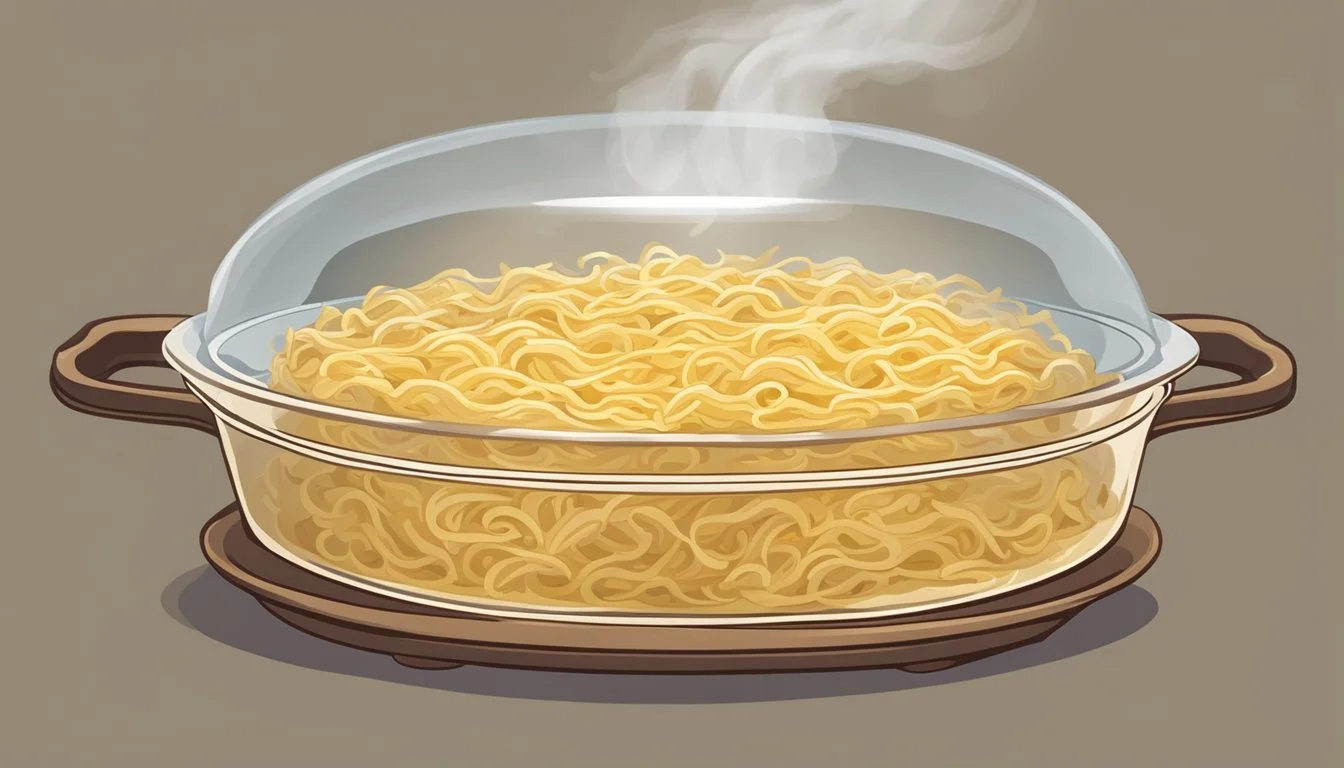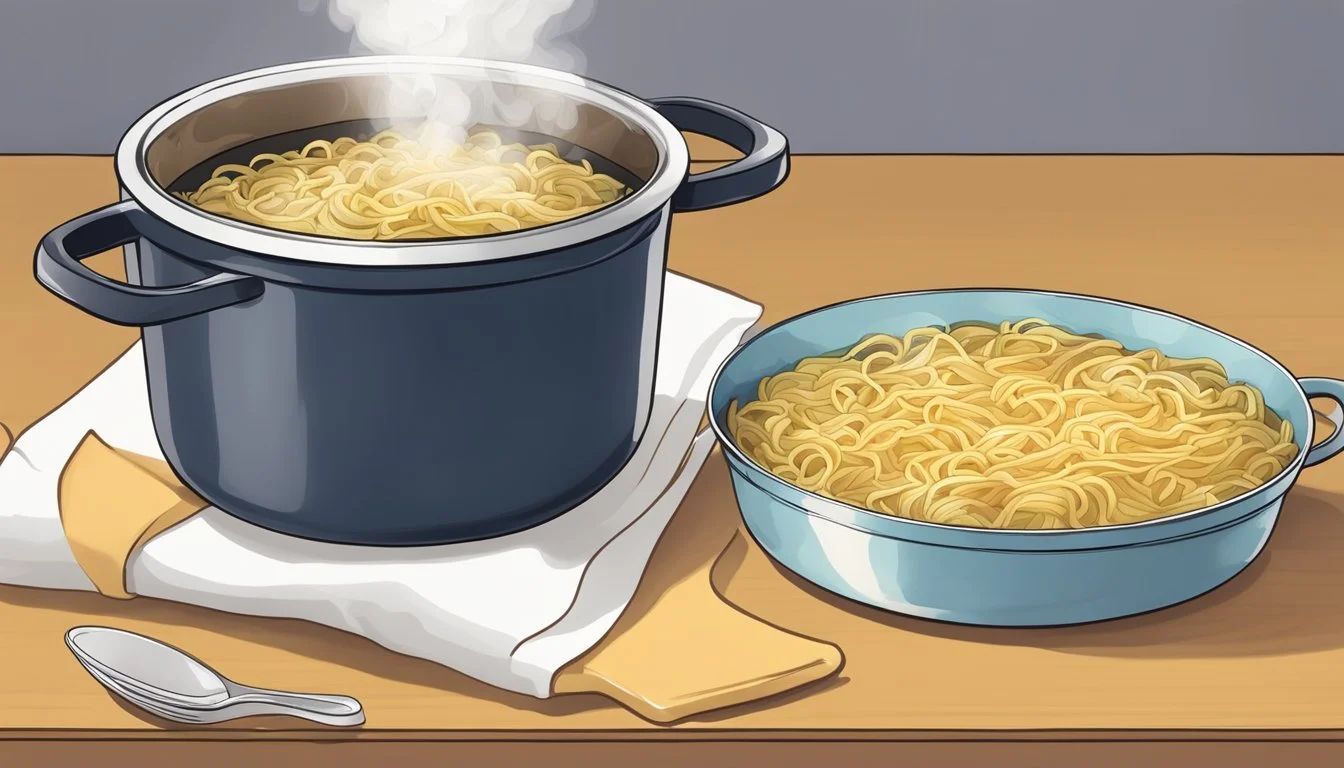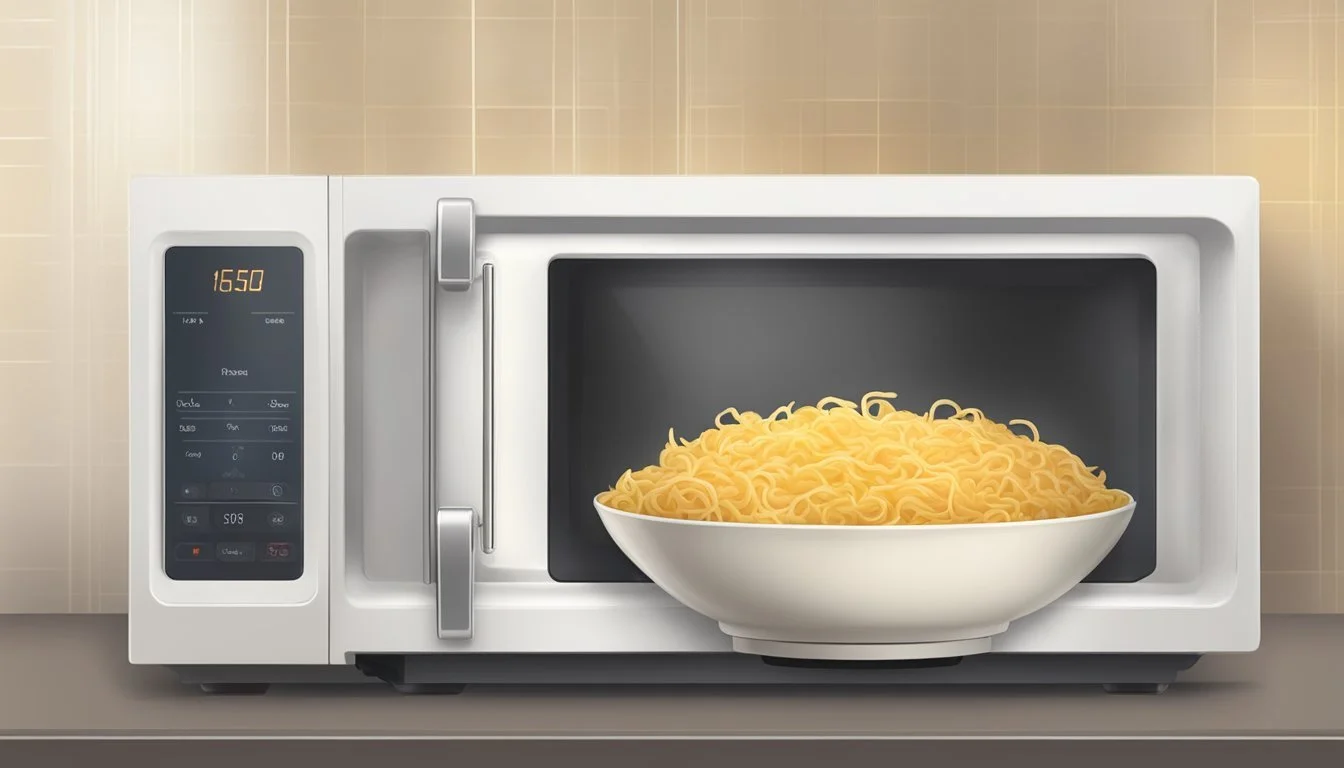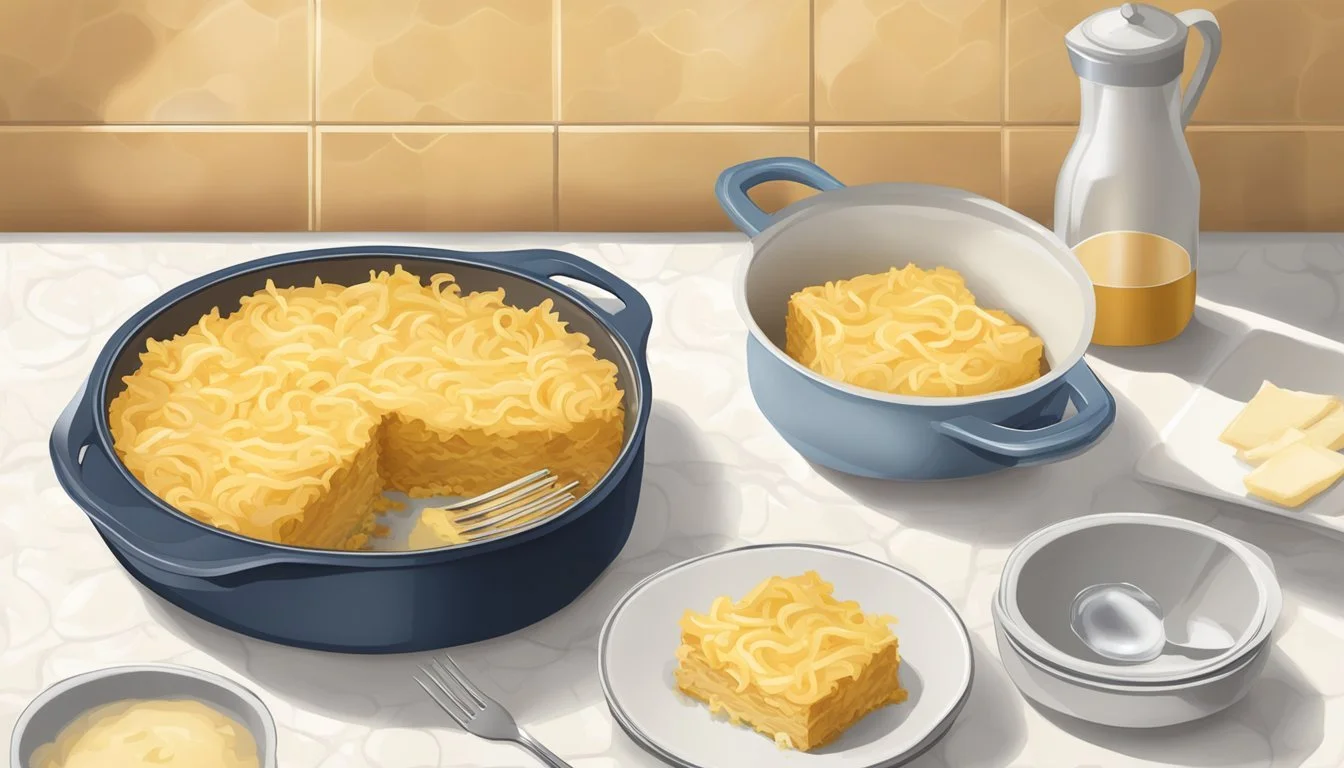Best Way to Reheat Noodle Kugel
Ensuring Moistness and Tender Noodles Every Time
Noodle kugel, with its comforting and creamy texture, often calls for a second serving. The key to enjoying leftover kugel is to reheat it properly to retain its moisture and keep the noodles tender. Different reheating methods can affect the dish's texture and flavor, so selecting the right technique ensures that the kugel remains as delectable as when it was first baked.
Oven reheating is the preferred method to warm up a noodle kugel thoroughly while preserving its creamy interior and avoiding dryness. The process involves preheating the oven to a moderate temperature, transferring the kugel to a baking dish, and if necessary, adding a little moisture to prevent it from drying out. It's then covered with foil to trap the steam and slowly reheated until it reaches the desired temperature.
Microwave reheating offers a quicker alternative but requires careful attention to avoid uneven heating. Cutting the kugel into smaller portions can promote a more uniform warming. It is essential to cover the dish with a microwave-safe lid or plastic wrap, leaving a corner open for steam to escape. This method rapidly restores the kugel's warmth while maintaining its tenderness, making it an ideal option for those with less time.
Understanding Noodle Kugel
Noodle Kugel is a traditional Jewish dish rich in history and flavor, constituting primarily of egg noodles and a sweet or savory custard.
Historical Significance of Noodle Kugel
Noodle Kugel has long been a staple in Eastern European Jewish cuisine, often served during Sabbath and festive holidays as a symbol of comfort and tradition. Its origins can be traced back several centuries, and it has since evolved, with various family recipes being handed down through generations.
Key Components of Noodle Kugel
The essential ingredients of Noodle Kugel are egg noodles and a binding custard mixture, which typically includes large eggs, sour cream, cottage cheese, or cream cheese. Sweet versions of the dish might add raisins, apples, brown sugar, and cinnamon, while savory varieties might forego sugar and fruit, instead focusing on the richness of the dairy and the egg.
A well-made Kugel achieves a balance between a tender noodle texture and a creamy, comforting custard, often enhanced with a dash of vanilla extract or highlighted with ground cinnamon for extra warmth and complexity. The result is a heartwarming dish that can be served as a dessert or a side, reflecting its versatility and historical roots.
Preparation Tips Before Reheating
Proper storage and pre-heating adjustments are vital to ensure that reheating noodle kugel retains its moisture and tenderness. Here's how to prep your kugel to get the best results.
Storing Noodle Kugel Properly
In the Fridge: Noodle kugel should be stored in the refrigerator if it will be reheated within a few days. It must be cooled to room temperature before being wrapped in aluminum foil or plastic wrap. For longer storage, wrap it tightly and keep it in an airtight container to maintain its quality.
In the Freezer: For extended storage, noodle kugel can be frozen. Wrap it securely in plastic wrap followed by aluminum foil to protect against freezer burn. It's best to thaw the kugel in the refrigerator overnight before reheating it to ensure even warming.
Choosing the Right Containers
When reheating noodle kugel, select an oven-safe baking dish if using the oven. For microwave reheating, a microwave-safe dish is crucial. Always use containers that provide space for covering the kugel, which will help in trapping moisture during the reheating process.
Pre-Reheating Adjustments
Before reheating, add a small amount of liquid, such as milk or water, to the kugel to prevent it from drying out. If the kugel was stored in the freezer, ensure it's completely thawed in the refrigerator to prevent cold spots during reheating. Cover the dish with parchment paper or a lid to allow for even steam distribution. This step is essential for keeping the noodles moist while avoiding the edges becoming too crisp.
Reheating Methods
Achieving the ideal balance of moisture and tenderness in reheated noodle kugel requires selecting the appropriate method and carefully managing the temperature and heating time.
Reheating in the Oven
To reheat noodle kugel in the oven, one should preheat to 300°F (150°C) or for a quicker warm-up, 350°F (175°C). The kugel should be placed in a ceramic or glass baking dish to evenly distribute heat. If it's dry, add a few tablespoons of water or oil over the top, then cover with aluminum foil to retain moisture. Warm the kugel for 25-30 minutes at the lower temperature or until thoroughly heated through at the higher temperature.
Microwaving Noodle Kugel
When using a microwave, place the noodle kugel on a microwave-safe plate, optionally in smaller chunks for even heating. Cover with a lid or plastic wrap, leaving a corner open for steam. Heat for 1 to 1 ½ minutes, check, and then continue at 15-second intervals if necessary, stirring in between to maintain the noodles' texture.
Using the Stovetop
For reheating on the stovetop, heat a non-stick frying pan with a splash of cooking oil over medium heat. Once hot, add the noodle kugel and stir consistently, allowing it to reheat for 4-5 minutes or until it's thoroughly warm, preserving the texture.
Utilizing an Air Fryer
One can reheat noodle kugel in an air fryer by setting it to a low temperature to avoid drying out the noodles. Preheat the air fryer to 300°F (150°C), place the kugel in the basket, and heat for a few minutes, checking periodically until the desired warmth and texture are achieved. Use a piece of foil to cover if there's a concern of drying out.
Adding Moisture to Reheated Noodle Kugel
When reheating noodle kugel, one of the main challenges is keeping it moist. Specific techniques and ingredients can help retain or add moisture to prevent it from drying out during the reheating process.
Using Liquids to Maintain Moistness
Adding Water or Broth: Gently sprinkling a few tablespoons of water or chicken broth over the kugel before reheating can aid in keeping the noodles moist. For every individual portion of kugel, one should consider using approximately 1 to 2 tablespoons of liquid.
Water: A cost-effective and easy method, adding a thin layer of water can provide sufficient moisture during heating.
Broth: Chicken or vegetable broth not only adds moisture but also infuses the kugel with a subtle savory flavor.
Dairy Additions: Dairy products provide both moisture and richness. Sour cream or cream cheese can be dotted on top of the kugel or lightly spread over the surface:
Sour cream: A couple of dollops of sour cream can enhance creaminess and ensure the kugel doesn't dry out.
Cream cheese: Small amounts of cream cheese, when melted, offer a creamy texture and tangy taste.
Enhancing Flavor and Texture
Incorporating Fats: Adding a bit of butter or grease can improve the taste and maintain the tender texture of the noodles.
Butter: Melting butter over the top before reheating can enrich flavor and protect the top layer from becoming too hard or crispy.
Grease: If available, using a tablespoon of schmaltz (chicken fat) can boosts flavor and moisture similar to butter.
Fruit-Based Moisture:
Applesauce: Incorporating a spoonful of applesauce not only provides moisture but also contributes a hint of sweetness, complementing the kugel's flavor.
Salt: A pinch of salt sprinkled along with other moistening agents helps to balance and enhance the overall taste.
Each of these methods can be tailored according to the size and portion of the kugel being reheated, ensuring that it remains deliciously warm with noodles that stay tender.
Reheating Frozen or Refrigerated Kugel
The proper reheating of noodle kugel from the freezer or refrigerator is essential to preserve its moisture and tenderness. Different techniques apply, depending on whether the kugel is frozen or has been stored in the refrigerator.
From the Freezer to the Oven
When dealing with frozen noodle kugel, one should preheat their oven to 350°F (175°C). It's important not to rush this process, as a properly preheated oven ensures even reheating. For a frozen kugel, the cook should transfer it directly into an oven-safe dish without defrosting.
Cover with Foil: To prevent the kugel top from drying out or excessively browning, cover the dish with aluminum foil.
Bake Time: Since it's frozen, a kugel may require a longer reheating time, approximately 30 minutes or until the center is thoroughly warm.
Refrigerated Kugel Considerations
For a kugel that has been stored in the refrigerator, the concern is keeping the pasta in the kugel moist during the reheating process.
Add Moisture: Sprinkle the surface with a few drops of water to reintroduce moisture.
Cover with Foil or a Lid: Similar to the frozen kugel, a refrigerated kugel should be covered to keep in the steam and heat evenly.
Bake: Place it in the preheated oven (350°F or 175°C). The kugel will likely need around 20 minutes to reheat, but this will vary depending on its thickness and size.
In both scenarios, cooks should refrain from adding oil to any salted water used as it can prevent sauces or seasonings from adhering effectively to the noodles upon serving. Whether handling a frozen or refrigerated kugel, patience is key to a well-reheated dish.
Garnishing and Serving Suggestions
Proper garnishing and presentation of noodle kugel can elevate this comforting dish into a delightful treat, whether one is serving it for brunch (What wine goes well with brunch?) or as a side dish. The right toppings and arrangement enhance both flavor and visual appeal.
Complementing the Kugel
For those who enjoy a sweet kugel, consider adding a sprinkling of powdered sugar, a dash of cinnamon, or a touch of nutmeg for an aromatic flavor that complements the creaminess of the kugel. Adding fresh berries provides a fresh, tart contrast to the dish's sweetness while offering a burst of color. For a richer garnish, light brown sugar can be added to the top before reheating to create a caramelized crust.
To incorporate a nutty, fruity dimension, chefs may suggest dicing dates and scattering them across the kugel, which pairs wonderfully with its inherent sweetness.
Presentation Tips
When presenting noodle kugel, attention to detail makes a difference. Here are some tips to ensure the kugel looks as good as it tastes:
Serve on a warm, neutral-colored plate to make the colors of the kugel and its garnishes pop.
For individual servings, use a round cutter to create uniformly shaped portions.
Garnish just before serving to maintain the freshness and texture; a light dusting of powdered sugar or cinnamon can be added through a sieve for an even coating.
By following these guidelines, one can present a noodle kugel that's as visually appealing as it is delicious, making it a memorable part of any meal.
Troubleshooting Common Reheating Issues
When reheating noodle kugel, maintaining the quality and texture is crucial. This section addresses how to prevent sogginess and resolve issues related to dryness or uneven heating to ensure a delightful eating experience.
Preventing Soggy Noodles
To avert sogginess during the reheating process, one should remember not to introduce too much moisture. If the kugel seems a bit dry, sprinkle just a few drops of water before covering. This minimal addition of water generates sufficient steam within the oven or microwave, which rehydrates the egg noodles without making them soggy.
Oven Method: Cover the kugel with foil to retain moisture without compromising texture.
Microwave Method: Encircle the dish with a paper towel that traps steam and promotes even heating without excessive moisture.
Resolving Dryness or Uneven Heating
Dryness can detract from the kugel's richness, and uneven heating might yield cold spots. Here are steps to ensure even warmth and to reintroduce moisture for a more palatable result:
Adding Moisture: If the kugel has dried out, misting the surface lightly with water or drizzling with a small amount of melted butter helps restore moisture content.
Ensuring Even Heating:
Oven: Bake at 350°F (175°C) for even warmth. Heat the covered kugel until just heated through, as overbaking leads to dryness.
Microwave: Heat in short bursts, checking and stirring (if possible) between intervals to distribute heat and prevent overheating any particular section.
With careful attention to these tips, one can readily navigate common reheating issues, resulting in a noodle kugel that is moist and tender.
Alternative Uses for Leftover Noodle Kugel
Leftover noodle kugel presents an opportunity for culinary creativity. Here are distinctive ways to breathe new life into this traditional dish.
Creating New Dishes from Leftovers
Leftover kugel can easily be transformed into a savory brunch item or a sweet dessert. For a brunch twist, one might lightly fry slices of kugel until the exterior is crispy and serve with a dollop of sour cream or applesauce. To transition into a dessert, one could top reheated kugel with a sprinkle of brown sugar or cinnamon, adding a new layer of sweetness.
Incorporating additives like raisins or crushed pineapple can enhance the moisture and flavor profile of the leftovers while turning them into entirely different dishes. A creative chef might consider making a kugel pudding by combining pieces of leftover kugel with a custard base, replete with raisins, and baking until set.
Incorporating Kugel into Other Recipes
Leftovers can serve as a sturdy base or add-on for various other recipes:
Savory Kugel Spinach Quiche: Utilizing a cooking spray-treated dish, layer chunks of kugel mixed with spinach, beaten eggs, and black pepper, then bake until the mixture sets.
Kugel Flavored Meatballs: Integrate finely chopped kugel into a meatball mixture for an unexpected hint of sweetness, paired excellently with savory sauces over meat or fish.
Fish Fillet Topping: Crumble the kugel and mix it with melted butter and herbs, then spread it over fish fillets as a crust, providing a contrasting texture after baking.
In each suggestion, the kugel is not just a leftover; it's a versatile ingredient that can elevate an array of dishes.






